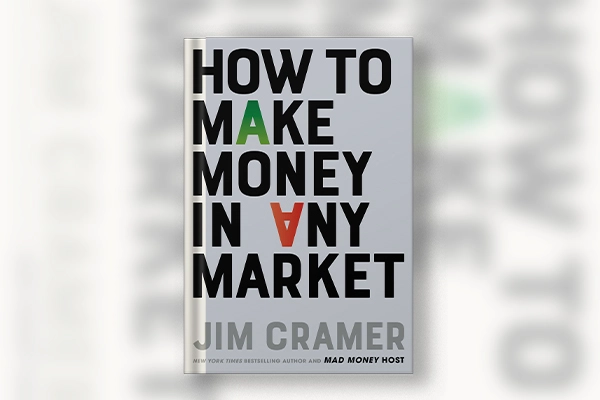How to Make Money

For many people, the stock market feels like a complex and intimidating game. It seems designed for professionals on Wall Street, leaving the average person on the sidelines, feeling hopeless about building real wealth. There’s a common, paralyzing fear that opportunities have been “nailed shut” and that it’s impossible for this generation to become as wealthy as their parents.
But what if there’s a different way to think about investing? What if the tools to succeed are more accessible than ever, and the most powerful insights don’t come from complex financial models but from your own life? This post distills five of the most surprising and impactful takeaways from Jim Cramer’s radical plan to democratize investing. These ideas challenge conventional Wall Street wisdom and empower you to take control of your financial future.
The 5 Most Impactful Takeaways
1. To Get Rich, You Need More Than an Index Fund
The financial industry almost uniformly insists that you park your money in a passive index fund and forget about it. While the author agrees that an S&P 500 index fund is a useful and safe part of any portfolio, he makes a bold and counter-intuitive claim: it will only make you money, not make you rich.
While an index fund can make you money, individual stocks can make you rich.
To illustrate the difference, consider the performance of the famous FANG stocks. According to the source, between February 2013, when Cramer introduced the famous FANG acronym, and the end of 2024, a $4,000 investment would have become:
- In an S&P 500 Index Fund: $19,400
- In FANG Stocks: $82,655
The author’s rationale is simple: You will not get rich owning index funds because they are just an amalgamation of a few strong stocks—the ones you should be buying on their own—and a bunch of mediocrity or worse.
This idea is radical because it cuts against the grain of modern financial advice, which often steers individuals away from picking their own stocks. The author’s plan is built on pairing the safety of an index fund with five “hero stocks” of your own choosing—the companies you believe have the power to generate extraordinary returns.
2. Market Crashes Aren’t a Threat; They’re an Opportunity
Fear is the single biggest reason people fail to build wealth in the market. We see headlines about crashes and corrections and instinctively want to run for cover. The author presents a completely different mindset: market sell-offs are not a threat to your portfolio; they are the nourishment it needs to grow.
Do you ever garden? Consider the stock market to be the soil in which you plant your seeds. Do you fear rain? No, you welcome it. That’s what sell-offs are all about; they nurture your picks.
This isn’t just a metaphor; it’s a strategy grounded in history. The author states that in the 40 years he has worked on Wall Street, every single market decline has been worth buying. The key psychological insight is that you only lose money in a crash if you “book the losses” by selling your shares in a panic. The long-term investor understands that the market has always recovered from downturns and continued its ascent to higher levels.
This mindset transforms fear into a strategic advantage. It reframes moments of widespread panic as the greatest opportunities to put more money to work, buying superior companies at a discount.
3. The Professionals Aren’t on Your Side (And You Don’t Need Them)
Wall Street has a vested interest in making investing seem overly complicated. The author argues that this is a deliberate strategy designed to make you feel like you need a professional to manage your money, allowing firms to capture your assets and charge hefty fees.
The reality is that the financial industry is not structured to serve the average American. The author tells the story of his own wife, who was “booted from her longtime wealth adviser because she didn’t have enough money in her account”—a sum of $100,000. At firms like Goldman Sachs, wealth advisors are busy “hunting for elephants”—clients with hundreds of millions of dollars—because they generate far more in fees.
But the world has changed. The information and tools once reserved for professionals are now at everyone’s fingertips. With AI services like ChatGPT and Perplexity, research that used to take hours can now be done in minutes. This is an incredible and empowering shift. Contrast today’s simple prompts with the author’s own past struggles: the “lame trips to the New York Public Library,” the “arduous” process of using a microfiche reader, and the frustration of finding only “useless,” months-old filings. You care more about your money than anyone else, and you now have the tools to cut out the indifferent middleman and manage it yourself.
4. Your Greatest Investment Edge Is Your Own Life
You don’t need a Ph.D. in finance to find winning stocks. According to the author, the best stock ideas are “observable to anyone who bothered to look.” Your greatest investing advantage comes from your own life, your own job, and your own powers of observation.
The source tells the story of “Mr. Hank,” a local paper bag salesman who quietly became a millionaire. He didn’t have special access or complex spreadsheets. He simply saved consistently and bought stock in a local company he knew and trusted from his own experience: Merck. In another example, the author realized the immense brand power of Apple when his young daughter told him she wanted a second iPod because it was like “jewelry.”
This approach stands in stark contrast to the author’s own early failures, like when he lost his money buying stock in an orange grove company (American Agronomics) based on a magazine article, without any personal knowledge of the business. This principle is transformative because it reframes investment research. It’s not about deciphering arcane financial documents; it starts with simple curiosity about the products you use, the brands you love, and the companies you interact with every day.
5. “Buy and Homework” Trumps “Buy and Hold”
“Buy and hold” has been the mantra of long-term investing for decades. But the author argues for an update: “buy and homework.” This doesn’t mean you should abandon your positions. Instead, it means you should stay invested for the long term while also staying informed to ensure the fundamental story of the company hasn’t gone wrong.
This “homework” is no longer arduous. For a portfolio of five stocks, it primarily involves paying attention four times a year when each company reports its earnings. By listening to or reading the conference call transcript, you can stay on top of the business. This commitment might add up to just twenty hours a year.
This approach is disciplined and manageable, striking a perfect balance. It avoids the neglect of passive investing and the high-risk, high-stress nature of frequent trading. As Home Depot cofounder Ken Langone noted, the majority of stock market profits are made on only about eight days a year—days that hyperactive traders are very likely to miss. As the author illustrates, “We had one of these days recently, April 9, 2025, when, after a bad series of losses, we had a Dow Jones point gain of 2,963, in fact the largest point gain ever. If you missed that one day, you might have missed your year’s gains!” “Buy and homework” keeps you in the game to capture those gains while ensuring your investments remain sound.
Conclusion: It’s Time to Take the Wheel
The central message is clear: investing is not as complicated, exclusive, or scary as it has been made out to be. You are smarter and more capable than the financial industry wants you to believe. You have the tools and, more importantly, the personal insight to build real, lasting wealth.
The author’s own story is a powerful testament to this idea. At one point in his life, he was living in his car, yet he still managed to mail checks of $50 a month to his Fidelity fund. That small, consistent act of saving grew into an account now worth well over $1 million.
The opportunities are there for the taking, but they require a commitment. As the author concludes, when you give up on saving, you are giving up on yourself. Are you ready to stop making excuses and start building your future?
Jim Cramer is a bestselling author, financial expert, and media personality, best known as the host of CNBC’s Mad Money and cohost of Squawk on the Street. He is the founder of the CNBC Investing Club and TheStreet, and has authored several influential books, including Confessions of a Street Addict and Jim Cramer’s Mad Money. A former hedge fund manager, Cramer founded and led Cramer Berkowitz, achieving exceptional returns with an average annual gain of 24% over fourteen years. His financial career began at Goldman Sachs, where he served as a wealth advisor. Cramer is also a graduate of Harvard University and Harvard Law, combining his expertise in finance, law, and media to become one of the most trusted names in personal finance.
Book details
- Title: How to Make Money in Any Market
- Explanatory Title: —–
- Author: Jim Cramer
- Publisher: Simon & Schuster
- Publication Date: September 30, 2025
- Print Length: 320 pages
- ISBN-10: 1668088649
- ISBN-13: 978-1668088647
- Category: Stock Market Investing / Budgeting & Money Management

